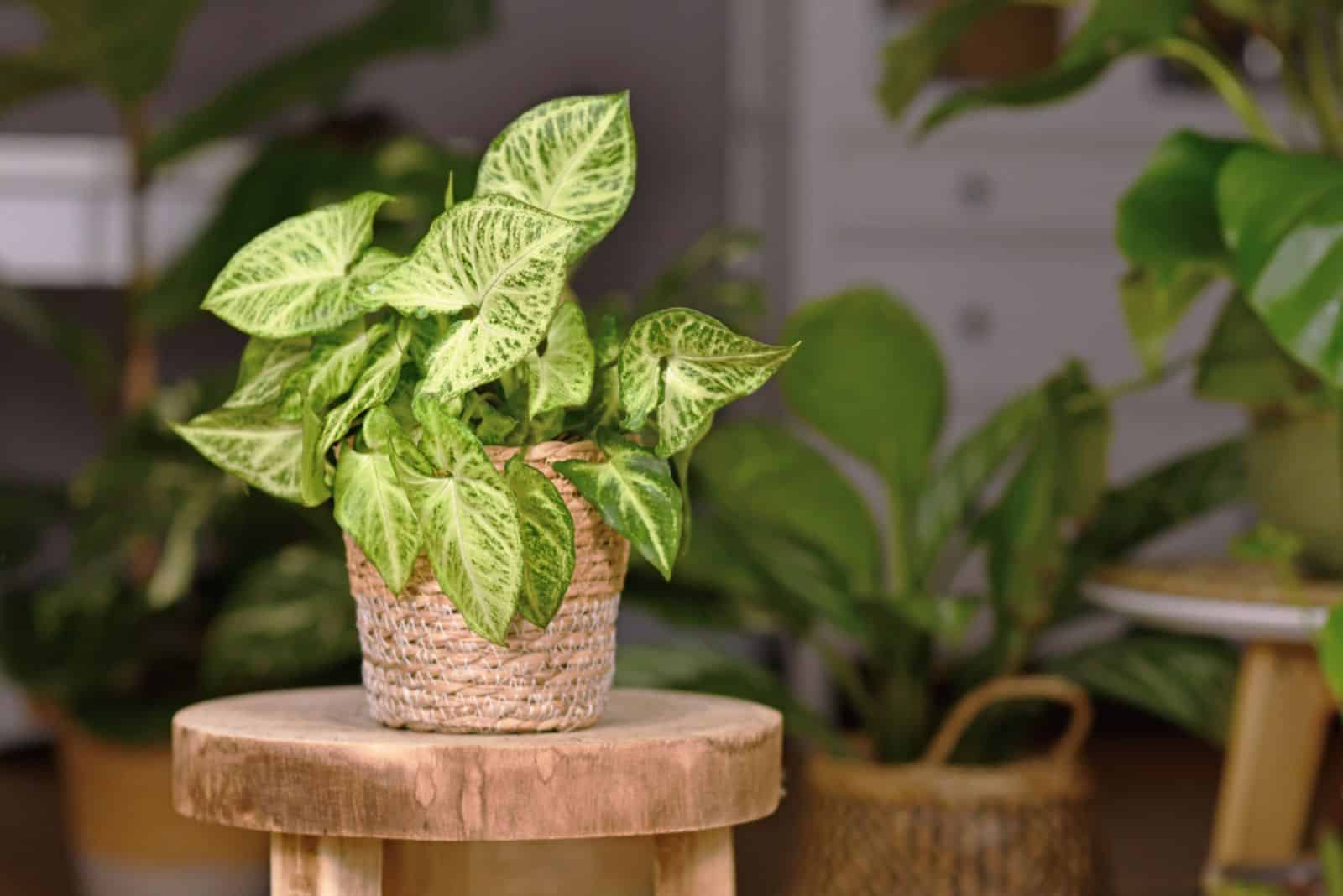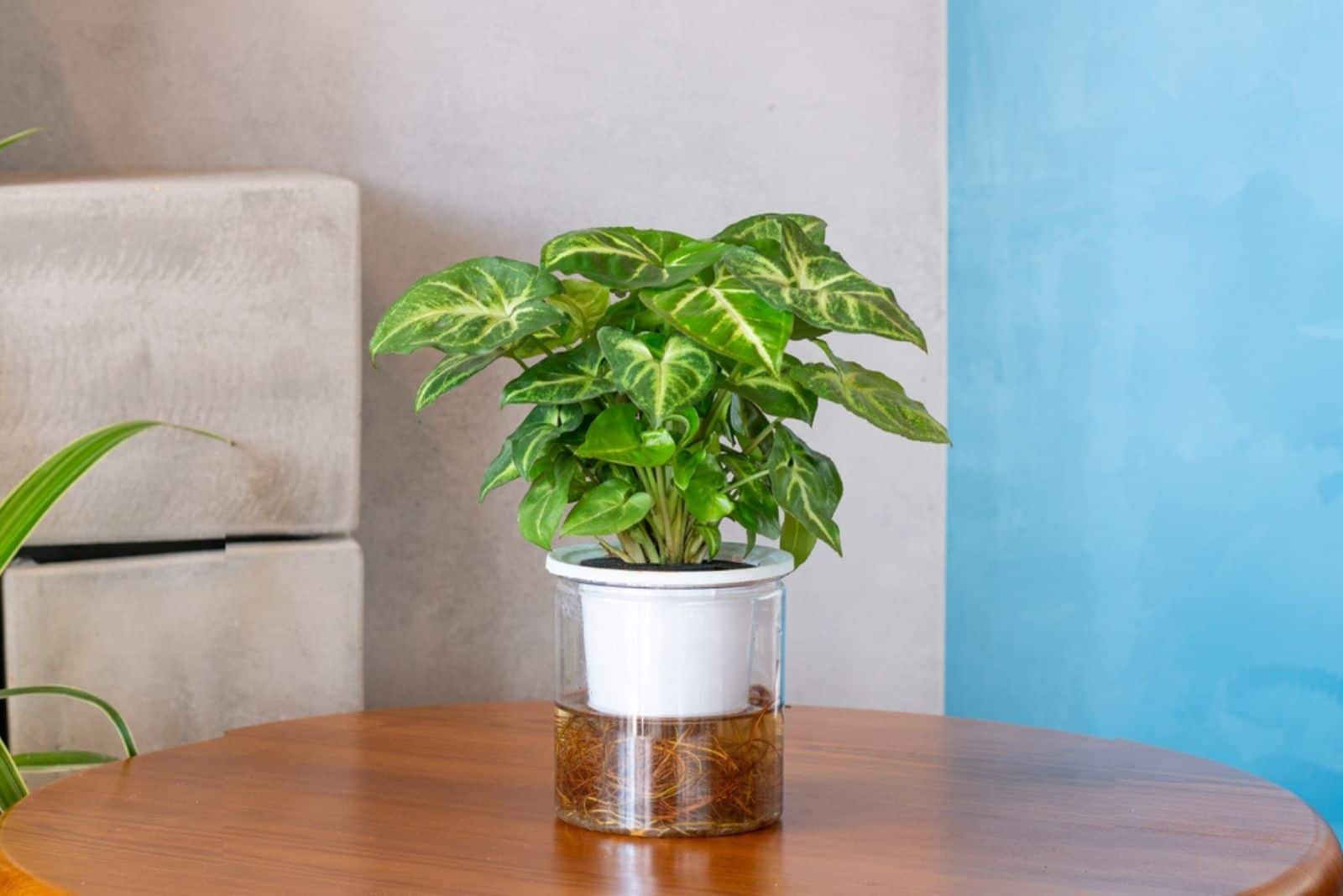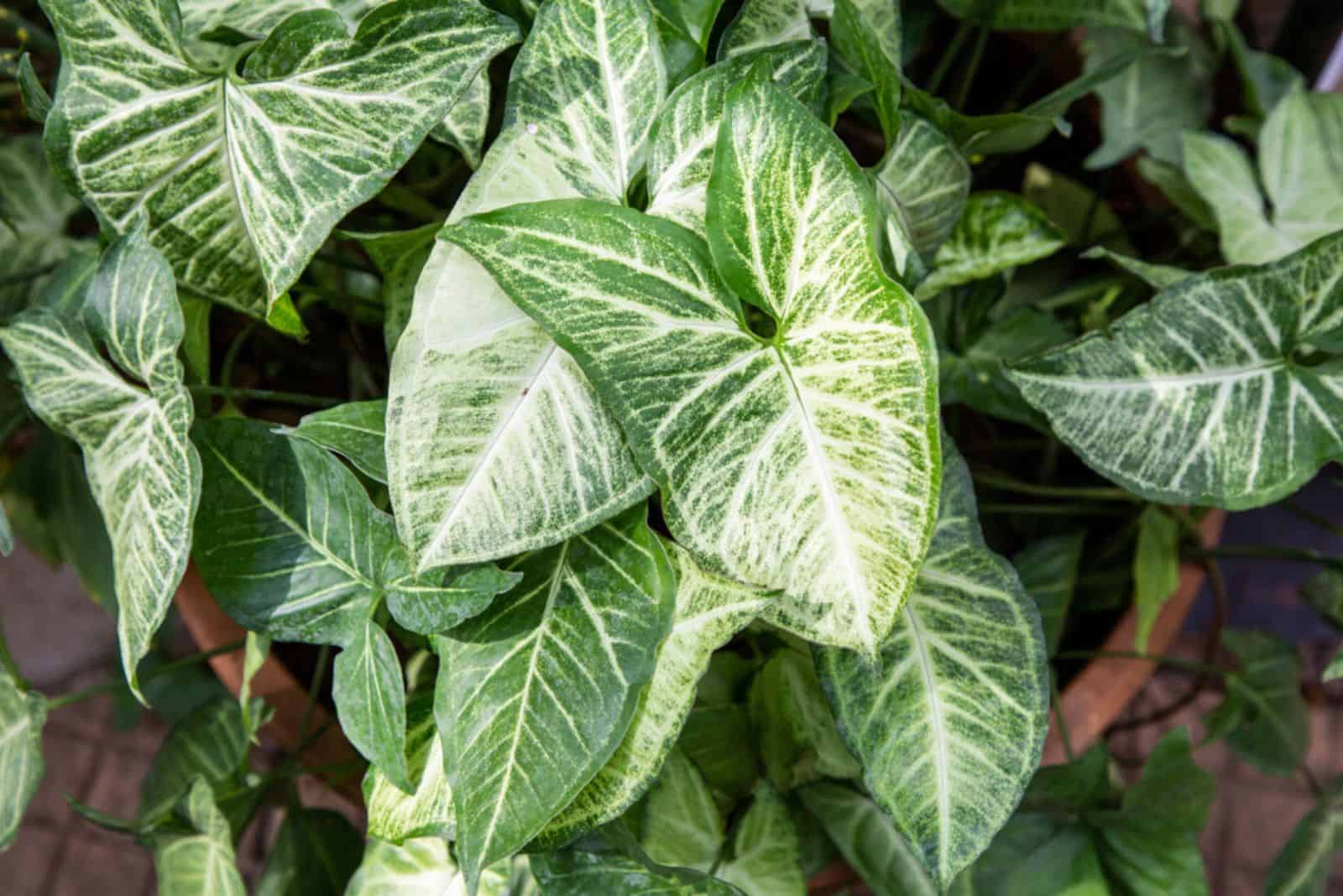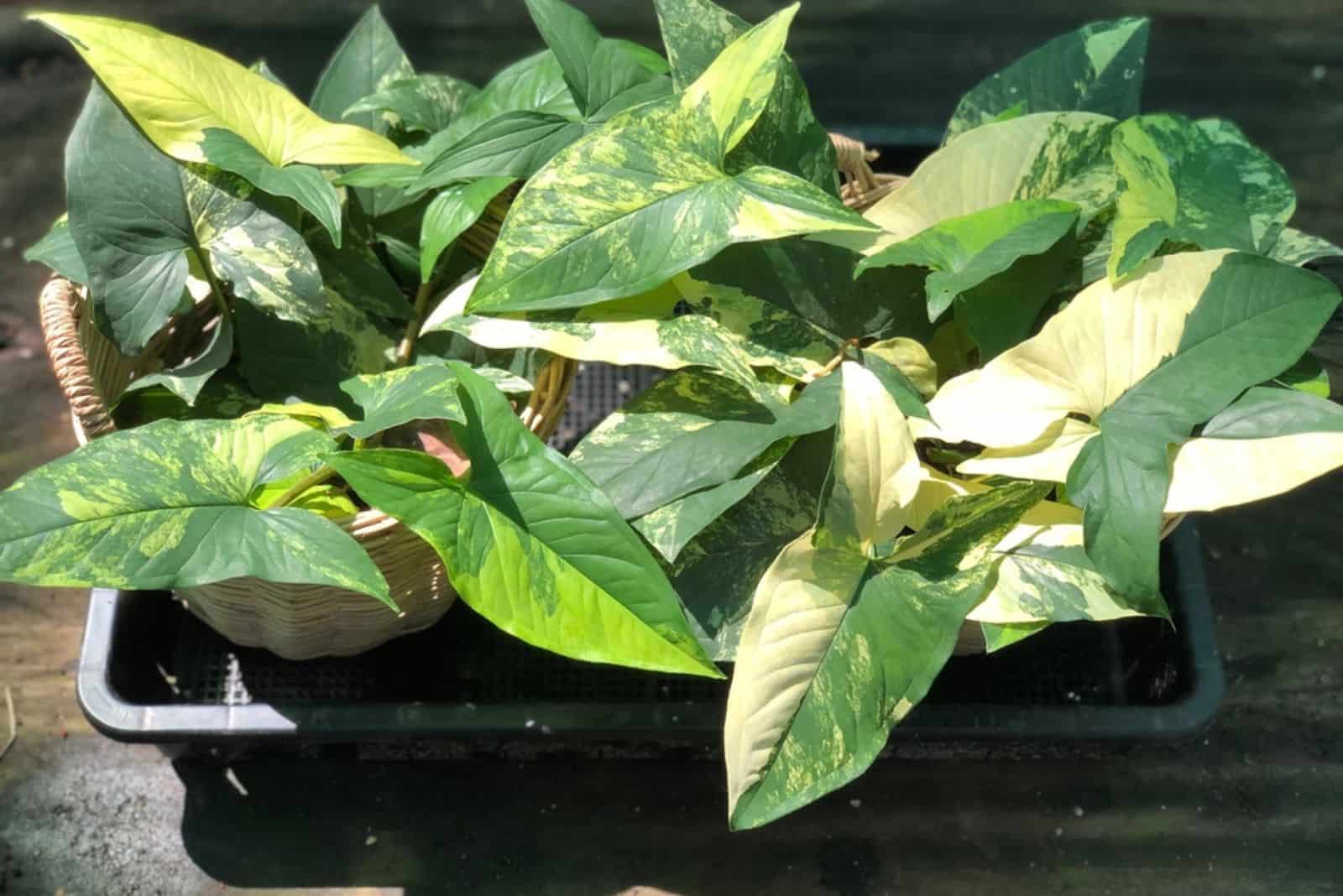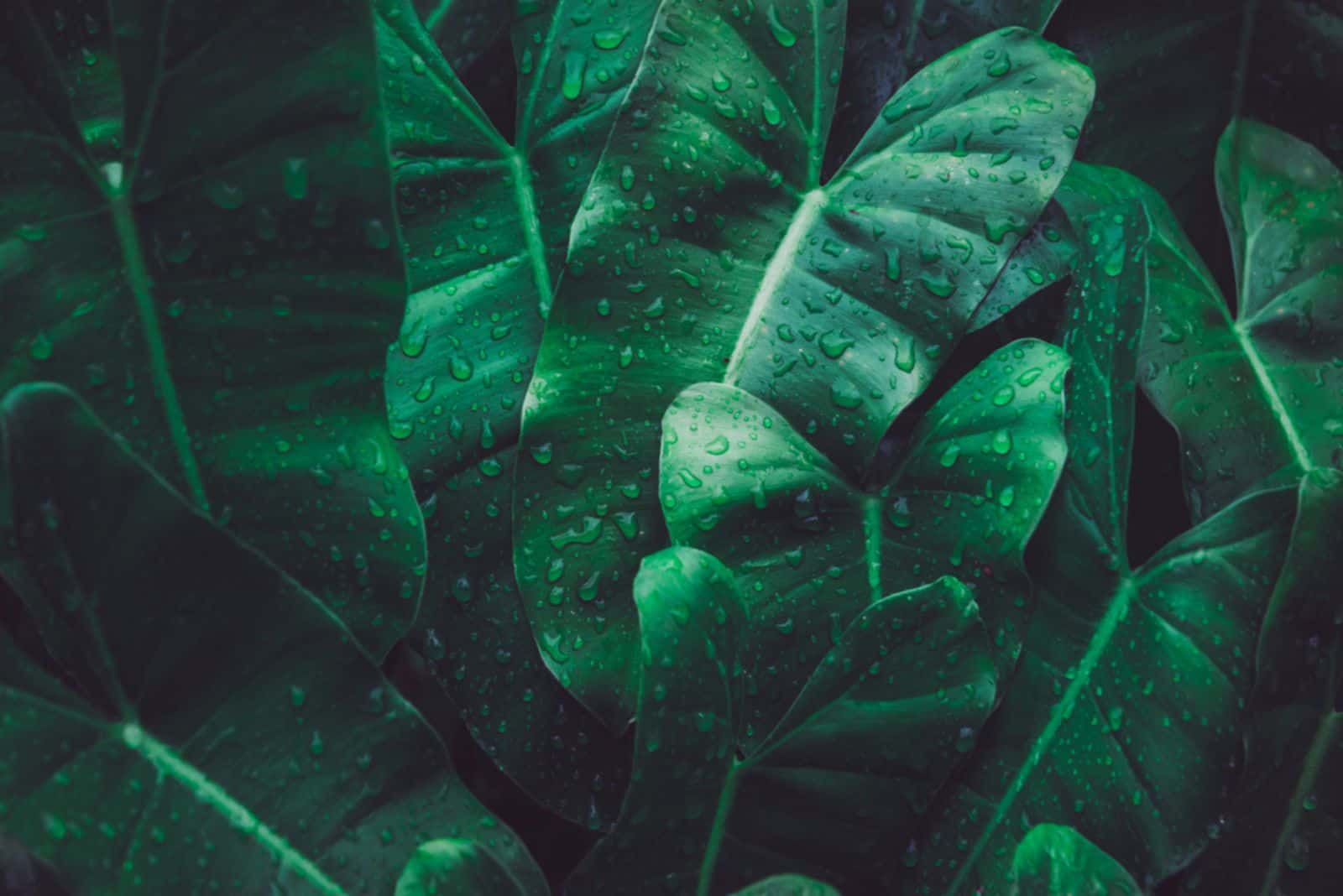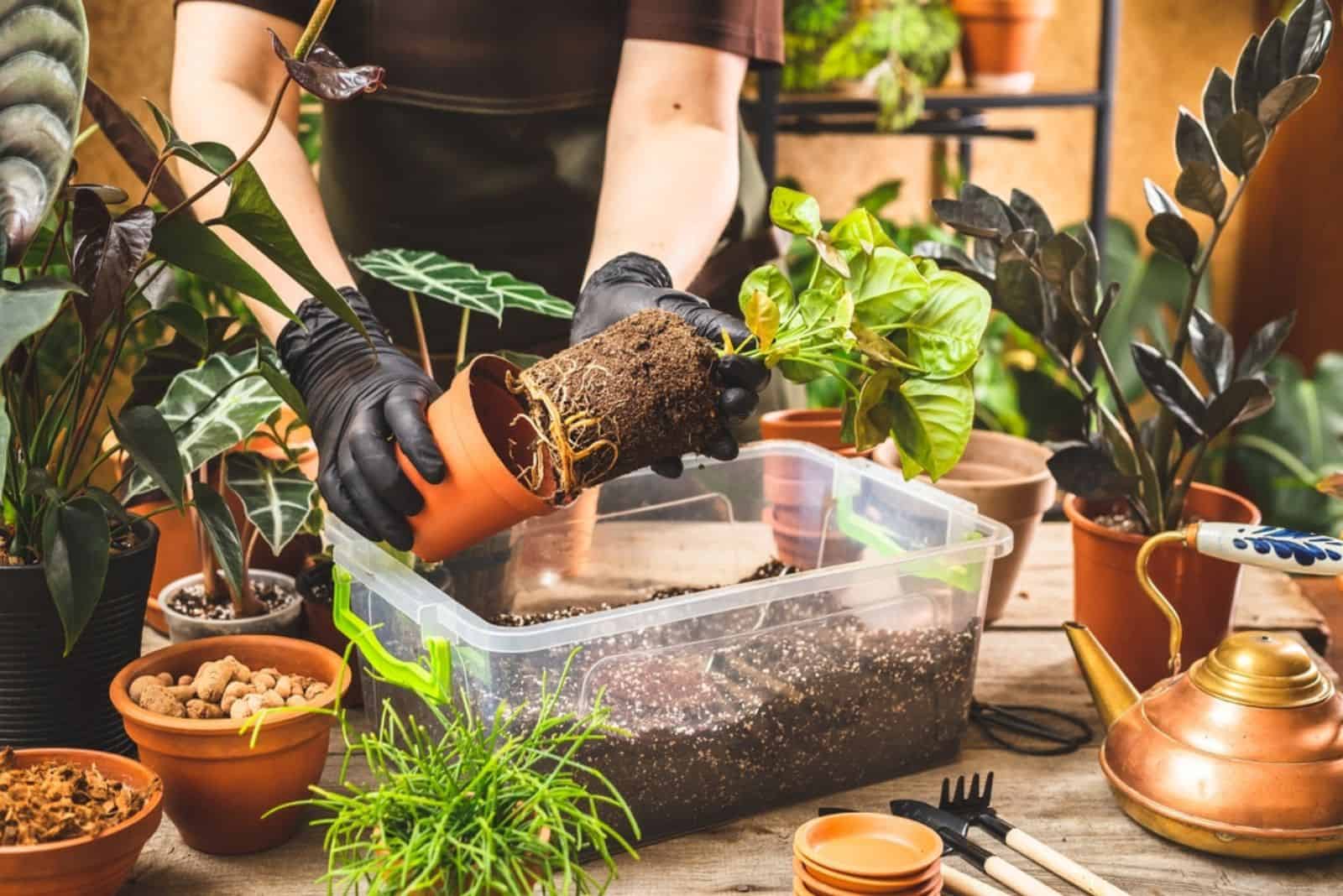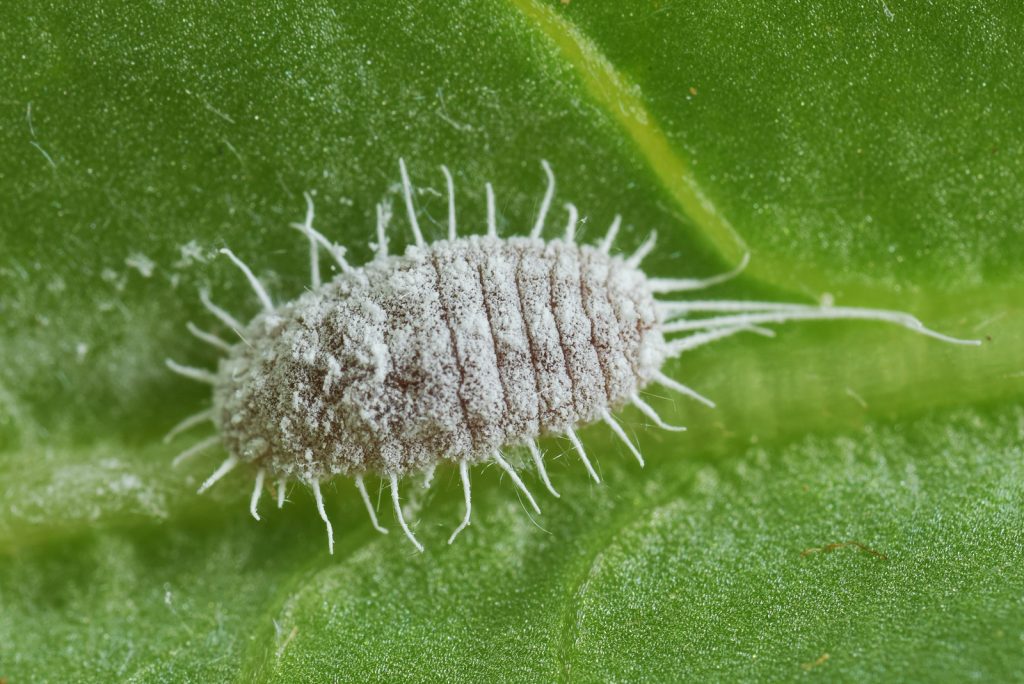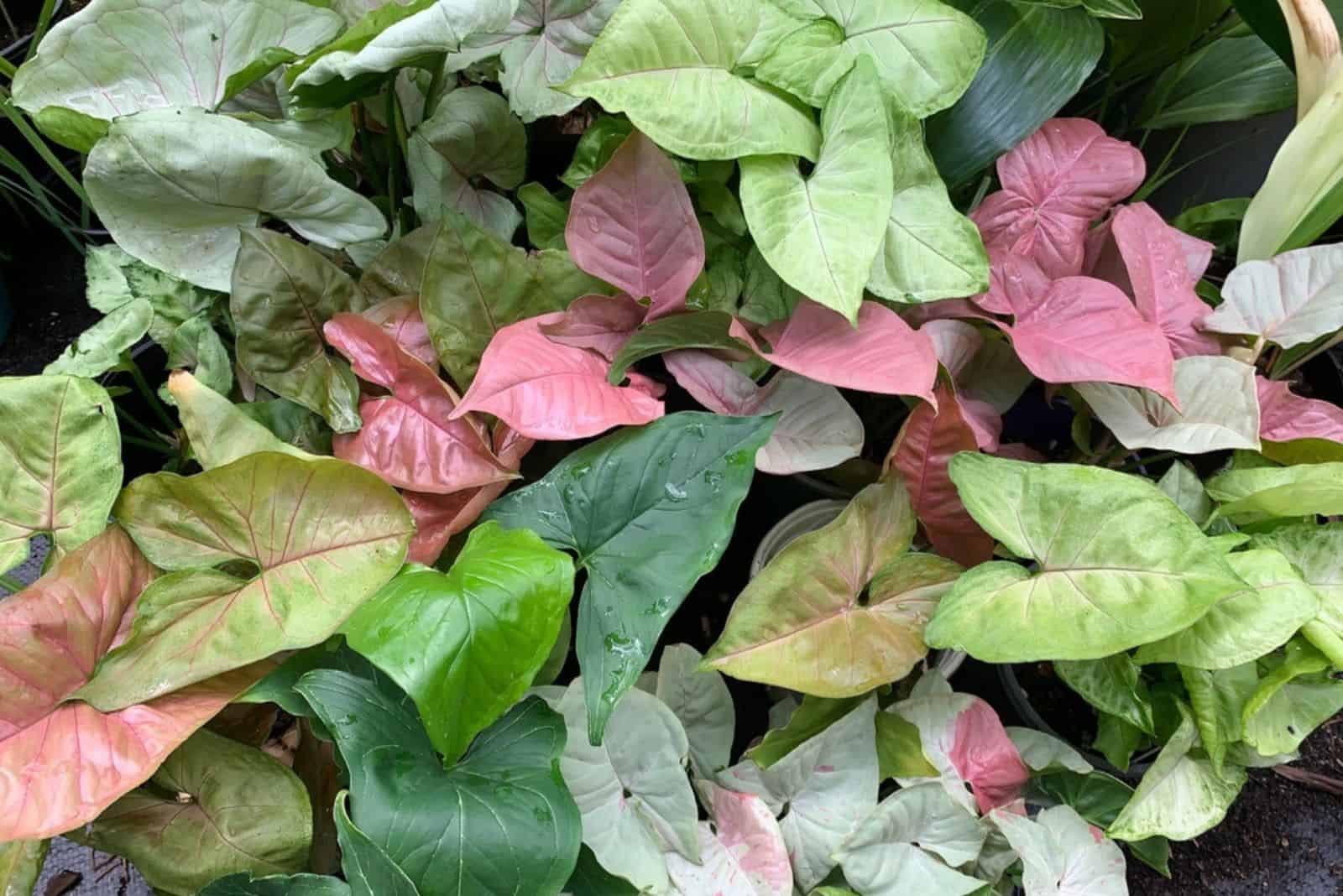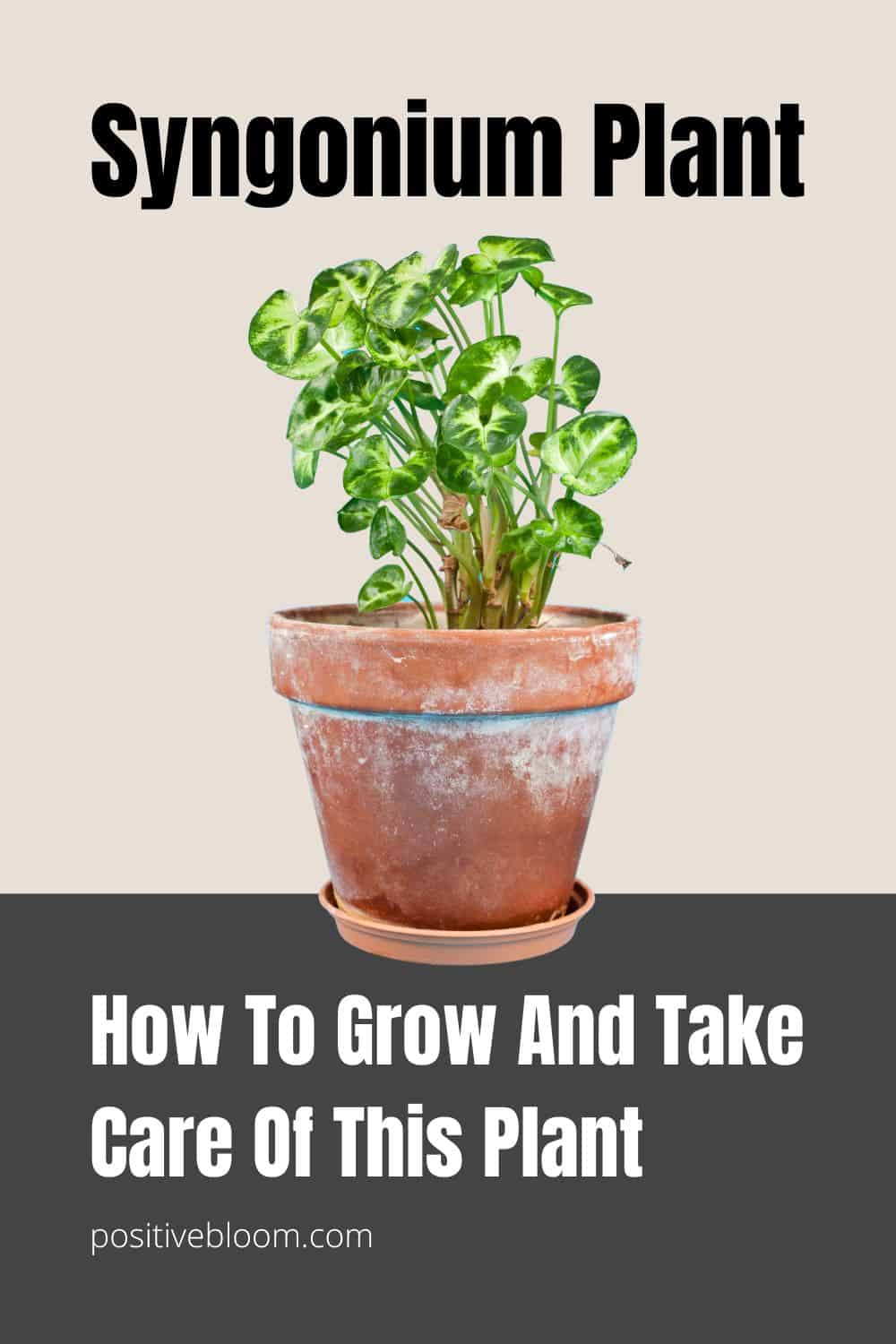If you want to try growing tropical plants indoors, even though they can be somewhat demanding and difficult to grow, then you should know that the best beginner tropical houseplant is definitely the Syngonium plant.
Also known as the Arrowhead plant, Syngoniums come in different shapes and sizes, and their variegated leaves have various unique patterns!
Young plants have bushy appearances, making them perfect for coffee tables and small shelves. As they grow, they produce lovely vines that can grow on trellises, poles, or even shelves nearby.
These plants are ideal for beginner gardeners, mainly because they are quite easy to grow and can also be used for practicing propagation. Keep on reading to learn more about this glorious plant!
Syngonium Plant: Common Features
Common names for the Syngonium plant include Arrowhead vines, Arrowhead plants, Goosefoot, and Nephthytis, and its botanical name is Syngonium Podophyllum. This plant belongs to the Araceae family.
It is an evergreen climbing plant that originates from the deep rainforests of South America, Mexico, Ecuador, Bolivia, and Brazil. This plant produces aerial roots that enable them to catch and climb all over the place!
Syngonium plants are suitable for growing in USDA hardiness zones 10 to 12, which means that it is usually grown as an indoor plant where you can control the temperature and humidity levels, and it is also winter hardy in warm places like Florida where it can be grown outdoors.
When it comes to Syngonium care, we can say that this plant is pretty low-maintenance. It is even considered to be one of the top 10 low-light indoor hanging plants. Other than regular pruning of their climbing vines and damaged leaves, you won’t have to worry about anything else.
The plant produces dark green leaves with different variegations. There are numerous Syngonium varieties that produce unique leaves — there is even one that produces pink leaves. If you want to know more about Syngonium varieties, scroll down!
You should also know that this plant is mildly toxic to both pets and humans. They contain calcium oxalate crystals that contribute to the plant’s toxicity. When chewed or consumed, the substance can cause swelling and symptoms such as gastric discomfort, salivation, and tingling or burning in the lips, mouth, tongue, and throat. A word of caution: If your lips or tongue swell up or if you have trouble breathing or swallowing, call your doctor immediately.
Growers usually grow this plant together with Monstera adansonii varieties, Philodendrons, Pothos, and Rhaphidophora Foraminifera, because they have similar plant care requirements.
How To Take Care Of A Syngonium Plant
As we mentioned, the Syngonium plant is relatively low-maintenance and easy to take care of. You can use this plant care guide for different plants in the same family, though the light conditions might vary due to the variegations on the leaves.
For instance, low light causes the variegated leaves to become greener, while direct sunlight might burn them. Therefore, you will have to find a perfect balance of bright and indirect light.
Now, let’s dive in!
Water Requirements
It is a tropical plant, so you already know that it absolutely loves frequent watering!
A tropical plant called the Syngonium Neon enjoys receiving lots of water. However, you shouldn’t submerge it completely because doing so will induce root rot.
As a general rule, we establish a watering schedule based on the requirements of the plant. Once the top few inches of soil feel dry to the touch, we tend to water the plant. However, if you leave the soil to completely dry out, that wouldn’t harm your plant.
But don’t leave your plant without water for too long!
Another useful tip is to plant the Syngonium in a pot with drainage holes so that it doesn’t sit in water all day.
Water your Arrowhead plant until you notice water flowing through the holes.
The frequency of watering also depends on the season, the amount of light, and the climate. It might be necessary to water your plant once a week if you live in a dry area. We water our Syngonium twice a month in the summer and once a month in the winter to maintain high humidity levels.
Please note that this plant enters dormancy in the winter season, so it will require less water and fertilizer.
Soil Requirements
This houseplant prefers potting soil with a pH of 5.5 to 6.5, which is mildly acidic. But there’s more!
A fertile substrate full of nutrients and organic matter is required for syngonium plants, as they need them to produce that lovely, vibrant foliage and climb all over the place!
To make your own Syngonium potting mix, pick up some perlite, vermiculite, and peat moss to go with your potting soil. This will allow you to make soil that is well-draining.
Light Requirements
Indirect light that is between moderate and bright is ideal for the Syngonium’s growth. It can survive low light levels, but if kept in complete darkness, the plant’s vibrant, light green color will fade, and if it doesn’t get enough light, your plant is likely to grow leggy.
Keep this plant in indirect sunlight for the best variegation, and avoid direct sun as it can lead to sunburn.
This plant requires a lot of light (at least 6 hours during the day); however, it is best to keep it in the shade if the only other option is direct sunlight.
However, as long as you keep it a few feet away from the window, this plant will flourish in the south-, west-, or east-facing rooms. You can always invest in artificial lighting if your apartment faces north because there are many different types of heat lamps for plants available.
Given that you can regulate how much light your plant receives, this kind of light exposure may be the safest. This plant only needs a moderate amount of light, so we often place grow lights between 200 and 300 watts throughout the day.
Fertilizer Requirements
During the plant’s growing season, you should fertilize it once a month using a liquid fertilizer — this works the best for Syngonium plants, though you can also use granular ones, just make sure that you follow the instructions!
Although they do not consume much food, they do benefit from occasional feeding. Alternatively, you can fertilize them each time you water them – just make sure to dilute the fertilizer with lots of water to prevent your plants from being harmed.
Fertilizers will improve new growth and new leaf production!
During dormancy, you don’t need to feed the plants, but you can give them a light fertilization once every two to three months.
To avoid overfertilization, always water the plants before feeding them.
Temperature Requirements
If you want a healthy plant, attempt to recreate the tropical climates that the lovely Syngonium plant is accustomed to.
Warm temperatures and high humidity are two characteristics of this environment. Although it prefers environments with temperatures between 60 and 80 degrees Fahrenheit (15 and 27 degrees Celsius), this Syngonium can survive in colder or hotter climates if other conditions, such as those for lighting, watering, and soil, are met.
It is frost-sensitive and can withstand temperatures as low as 50°F (10°C), but lower temperatures are deadly.
Additionally, Syngoniums dislike drafts and sudden temperature fluctuations; otherwise, they may wilt and droop.
Humidity Requirements
If you don’t live in a tropical area, it is recommended to grow the Syngonium plant inside, where you can regulate the environment and make sure all of its requirements are satisfied.
The ideal humidity range for Syngonium is between 60 and 90%. If you want a happy plant, you need to boost the normal household humidity, which is between 30 and 40%.
Here are some ways that you can boost humidity levels:
• Buy a humidifier — this is the easiest option, and you can find some good humidifiers for a reasonable price on Amazon!
• Create a pebble tray — put some pebbles in a tray, add some water, and put the plant on top of the tray. As the water evaporates, it will create enough moisture for your plant.
• Misting — you can mist your plant on a daily basis, though I avoid this method because it can attract pests and fungi.
• Grow it in a terrarium — the plant just needs to be watered before being placed in a glass container. You won’t need to water the plant for a few months because the soil won’t dry out as soon because the water will evaporate into the air around the plant.
Repotting
Although Syngoniums don’t grow quickly, they occasionally need to be repotted in order to prevent them from becoming rootbound.
They are usually repotted once every 2 to 3 years, though you could put your plant in a lovely hanging basket when it starts producing long vines.
Repotting this plant is best done in the spring or summer when it is actively growing. It dislikes having its slumber interrupted, and it requires time to become used to its new surroundings before winter.
Select a pot that is one or two sizes larger, add fresh potting soil, and then plant the Syngonium. Don’t expose the plant to harsh conditions, and give it plenty of water.
Propagation
This plant is very easy to propagate. All you have to do is find a healthy stem cutting with a few leaf nodes, put it in soil or water, and carefully nurture the baby plant.
Water Propagation
Syngonium can be propagated more quickly in water than in soil.
The first step is to choose a robust stem with healthy leaves and, ideally, aerial roots.
After that, cut off the bottom leaves and put the cutting in a water-filled container. Make sure there isn’t any vegetation submerged because it will just taint the water.
Place the jar in a bright area, and replace the water every other day.
In 3–4 weeks, you should detect the sprouting of new roots, at which point you should repot the plant.
Put it in a pot with fresh, moist potting soil, and keep it away from bad environments.
Soil Propagation
It is a little risky to propagate in soil because there is a possibility that your plant won’t survive. Therefore, you ought to always choose a stem with aerial roots.
Before planting it in a well-draining, well-aerated medium, trim the stem just below the leaf node, give it a rooting hormone dip, and then plant it there.
Maintain ideal water, light, and humidity conditions to increase your chances of success.
The disadvantage of this approach is that you won’t be able to see the roots growing, but as soon as you see that your plant has begun to grow, you should transfer it to a larger pot.
Pruning & Cleaning
Because it is a dust collector, the Syngonium plant must be cleaned on a regular basis.
After removing the dust with a moist cloth, dry the leaves — you can also let the leaves dry naturally instead.
Another crucial step in Syngonium maintenance is pruning. Cut off any leaves that are sunburned, infected, or otherwise discolored right away to prevent the infection from spreading and the plant from wasting energy.
This plant can also be pruned to maintain its bushy appearance, but never cut more than ⅓ at a time.
Common Issues
The Syngonium plant is known for being one of the best pest-free tropical plants. However, there are certain bugs that will still infest it.
Let’s look at some of this plant’s common issues.
Discolored Leaves
Yellow foliage is not only unpleasant to look at, but it’s frequently a sign of a more serious underlying problem.
Yellow leaves could indicate overwatering or underwatering of your plant. If you are unsure, look at the soil; if it is dry, water the plant. Wait a few days before watering your plant if it’s damp.
Yellow leaves may also be a sign that your plant isn’t getting enough nitrogen, in which case you should either switch to a different fertilizer or start using fertilizers if you weren’t already because these plants require additional food sources.
On the other side, your plant’s foliage could occasionally turn brown. If this occurs, dry air is most likely to blame. However, you can simply fix this by misting your plant or finding another technique to increase the humidity.
Last but not least, sunburns brought on by excessive direct sunlight can also result in brown foliage. Although these plants require intense light, direct sunlight can burn them, so you should keep them out of the sun.
Pests
The best way to stop bugs on your Syngonium is to meet its requirements because pests typically attack unhealthy, overwatered plants with damp leaves.
However, pests do occasionally attack our plants without cause, so understanding how to get rid of them is useful.
Aphids, mealybugs, scales, and spider mites are the most frequent insects that attack this plant. As soon as you see one bug, you should move the plant to a different location to prevent your other plants from becoming infected.
Next, apply neem oil or another insecticide to the plant, and wait until all the pests have disappeared.
Strong water pressure can be used to remove them if you prefer natural remedies, or you can do it yourself by using rubbing alcohol.
Diseases
These plants are fairly gentle, and they will let you know if they are subjected to poor conditions.
If you overwater them and keep their leaves wet for an extended period of time, they can soon become infected with root rot and leaf spot.
Yellow foliage that is wilting, drooping, and stunted in growth are a sign of root rot. The more quickly you take care of this issue, the more likely it is that your plant will live.
Replant the Syngonium in a fresh pot with a well-draining media after removing the soft and black roots. Another disease brought on by inadequate moisture requirements is a leaf spot. To stop this disease, you must refrain from spraying your plant too frequently and stop watering it from above.
On the other hand, you must quickly separate the contaminated plant from the others if you notice yellow, brown, or black spots on the leaves.
A fungicide should be sprayed on the plant after trimming the infected leaves.
In order to have a better chance of saving your plant, you must take action as soon as you see the signs of these diseases.
Read also: Copper Fungicide Vs Neem Oil: What’s The Better Option?
Syngonium Plant Varieties
There are about 16 different Syngonium varieties, and the prettiest one is definitely the Syngonium Neon Robusta, while the rarest Syngonium species is the Syngonium T25.
Here is a short description of the common Syngonium varieties:
1. Pink Allusion Nephthytis — this variety has large, light green leaves with dark margins. What’s unique about this species is that it has prominent pink veins protruding on the surface of the leaves.
2. Maria Allusion Nephthytis — a recent cultivar that has light green foliage and is strongly darkened and tinted with coppery pink.
3. The Syngonium Red Heart — given that its leaves are more heart-shaped than arrowhead-shaped, the Red Heart Syngonium is easy to identify. Their leaves have a lovely pink color.
4. Strawberry Cream Arrowhead Vine — young leaves produced by this variety have an intense pink color. As they mature, the leaves slowly fade. Brighter lighting enhances the color of the leaves.
5. White Butterfly Arrowhead Vine — this is the most common Syngonium variety. It has characteristic greenish-white leaves with dark green edges.
To Sum Up
The Syngonium plant is definitely a keeper!
I would recommend everyone add this lovely plant to their tropical plants collection — you can even combine different cultivars with those mesmerizing pink leaves. The Syngonium Red Heart is also a perfect gift for Valentine’s day as it produces heart-shaped leaves with reddish-pink colors.
These plants are low-maintenance, easy to propagate, and almost entirely pest-free. So, you will end up with a beautiful plant that can climb all over your place (that is, if you let it!).
I hope this article was helpful.
Until next time!
Like this post? Share or pin it for later!

